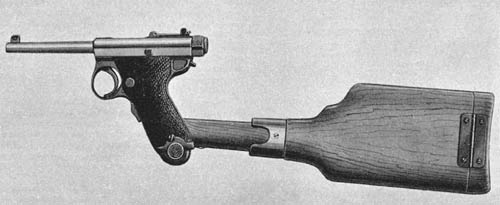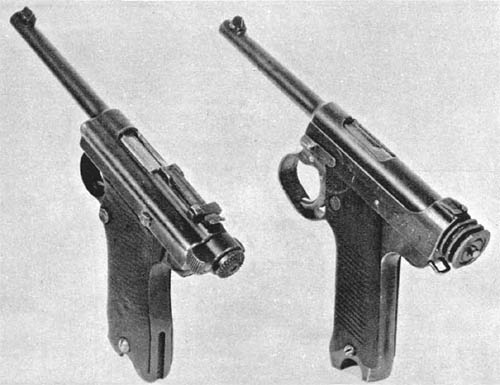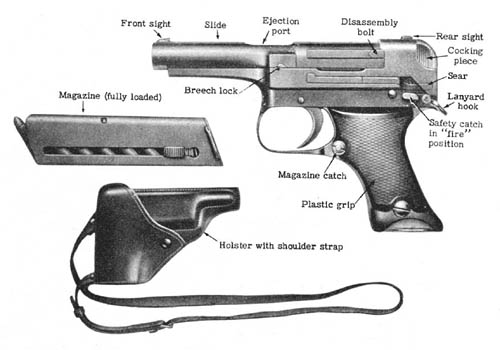A short guide for U.S. soldiers to WW2 Japanese pistols from Soldier’s Guide to the Japanese Army, Special Series No. 27, Military Intelligence Service, War Department, Washington, DC, November 1944.
Small Arms: Pistols
The Nambu 8-mm pistol resembles the German Luger outwardly but its mechanism is entirely different. Although both this pistol and the Model 26 (1893) 9-mm revolver are still in service, they are being replaced by the Model 14 (1925). The Nambu pistol is a semiautomatic, recoil-operated, magazine-fed hand weapon. Its eight-round magazine fits into the butt and is held secure by a catch similar to that on the U.S. service automatic pistol (M1911 or M1911A1 Colt .45). A wooden holster which has a telescoping section is used both as a holster and as a stock which may be attached to adapt the pistol for use as a carbine.
A grip safety just in front of the trigger guard catches the trigger in its forward position and prevents any rearward movement unless the safety is depressed.
To load and fire, a magazine is inserted into the butt and shoved home until the magazine-catch locks. To move a cartridge for firing, the cocking piece is pulled to the rear and let snap forward again. The pistol then can be fired by squeezing the grip safety and the trigger at the same time.
To unload, the magazine catch is pressed, allowing the magazine to drop out of the butt. The cartridge in the chamber is extracted by pulling the cocking piece to the rear as far as it will go, and letting it snap forward. As a safety precaution this operation should be repeated several times.
The Model 14 (1925) 8-mm pistol is an improvement on the Nambu and uses the same kind of ammunition. Its design is original but the workmanship is rather poor. Unlike the Nambu, the weapon is not fitted for a shoulder stock. Other identification features that distinguish this weapon from the Nambu are the absence of a leaf sight, horizontally grooved wooden grips on the stock, and the absence of a recoil-spring housing on the left side of the receiver.
The weapon is a semiautomatic, recoil-operated, and magazine-fed. It has no slide; the barrel is extended to the rear and carries the ejection opening and sear for the bolt lock. The bolt moves inside this barrel extension, and energy for the forward movement is supplied by two coil springs situated one on either side of the bolt inside the barrel extension.
A safety lever is located on the left side of the receiver just above the trigger. When this is in the forward position the pistol can be fired; when in the rear position, the action is locked.
To load and fire, a loaded magazine is inserted into the well in the butt, while the safety lever is in the forward position. The cocking piece then is pulled rearward as far as it will go, and permitted to snap forward. The pistol then is loaded and ready to fire. It can be unloaded by pressing downward on the magazine, with the safety lever in the forward position. The button on the right side of the stock must be released, after which the magazine can be extracted. The cocking piece is pulled all the way back to eject a cartridge from the chamber.
Latest pistol model in use by the Japanese Army is the Model 94 (1934) semiautomatic 8-mm pistol. The quality of manufacture is poor in comparison with the Nambu and the Model 14.
This weapon is easily identified by its cramped grip, short barrel, and the slide which covers the entire barrel. It is semiautomatic, recoil-operated. and magazine-fed. The magazine is box-shaped and fits into the butt in the usual fashion.
A safety lever is on the left side of the receiver. When it is in the horizontal position, the pistol can be fired; when it is pulled backward and up to the vertical position, the safety is operative.
The pistol is loaded by inserting a magazine into the butt until the catch clicks. With the safety in the horizontal (fire) position, the cocking piece is pulled to the rear as far as possible and then permitted to snap forward. To unload the magazine, the catch on the left side of the receiver is pressed inward and the magazine is extracted. The piece is “cleared” by working the slide back and forth several times, as would be done with the U.S. automatic pistol.
Pistols—Table of Characteristics
Nambu 8-mm
Caliber 0.315 inch Principle of operation Recoil-operated, semiautomatic Ammunition Semirimmed, bottle-necked case, roundnose bullet Capacity of magazine 8 rounds Effective range 50 feet Muzzle velocity 950 feet per second Model 14 (1925) 8-mm
Caliber 0.315 inch Principle of operation Recoil-operated, semiautomatic Ammunition Semirimmed, bottle-necked case, roundnose bullet Capacity of magazine 8 rounds Effective range 50 feet Muzzle velocity 950 feet per second
Model 94 (1934) 8-mm
Caliber 0.315 inch Principle of operation Recoil-operated, semiautomatic Ammunition Same 8-mm semirimmed, bottle-necked cartridge as used in the Nambu and the Model 14 pistols Capacity of magazine 6 rounds Effective range 50 feet Muzzle velocity 900 feet per second
See Also: Japanese Pistols, Revolvers, and Rifles, TM-E 30-480: Handbook on Japanese Military Forces













The Model 94 pistol is as legendary as the Chauchat machine gun in the awful firearms category.
With the safety off and a round in the chamber, pressure on the exposed sear will cause the pistol to discharge without pulling the trigger.
Bad pistols, but good article. First rule of pistol design, dont fire if the trigger is not pulled.
A friend of mine has a model 94 in 22calibre. Can’t find any info on this cal. The pistol is original from ww2 Information can be sent to edklemencic@sbcglobal.net Thanks!